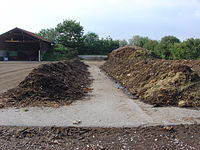
Photo from wikipedia
Abstract In this study, we investigated the enzymatical degradability and pilot-scale composting of 14 cellulose-based materials. The materials analyzed here were cellulose regenerated from ionic liquid (EMIM[OAc]), carboxymethyl cellulose (CMC)… Click to show full abstract
Abstract In this study, we investigated the enzymatical degradability and pilot-scale composting of 14 cellulose-based materials. The materials analyzed here were cellulose regenerated from ionic liquid (EMIM[OAc]), carboxymethyl cellulose (CMC) crosslinked by aluminum salt (Al-salt), methyl cellulose, cellulose acetate, butylated hemicellulose: DS: 1, DS: 0.4, and DS: 0.2, cellophane, wet strength paper, nanocellulose, paper partially dissolved by IL, cellulose carbamate, cellulose palmitate, and cellulose octanoate. The aim of the study was to show how chemical substituting and the substituent itself influence the biodegradability of cellulose materials. The enzymatic degradation and pilot-scale composting of these films shows the correlation between the hydrolysis rate and degree of substitution. The enzymatic hydrolysis of cellulose-based films decreased exponentially as the degree of substitution increased. Modifying cellulose to the extent that it gains the strength needed to obtain good mechanical properties, while retaining its natural biodegradability is an important factor when preparing alternatives for plastic films. Graphic Abstract
Journal Title: Journal of Polymers and the Environment
Year Published: 2019
Link to full text (if available)
Share on Social Media: Sign Up to like & get
recommendations!